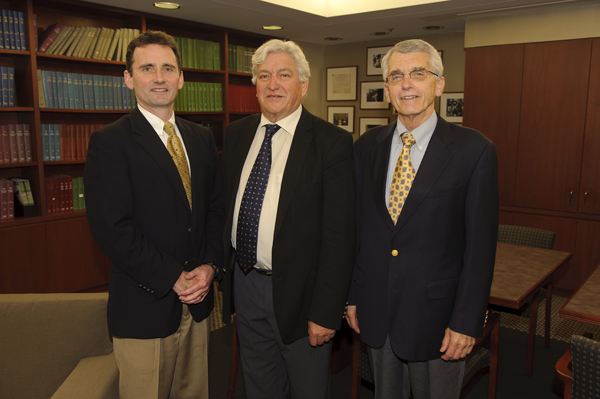- Home
- Patient Care
- Services
- Hip & Knee
- Adolescent and Young Adult Hip Disorders Center
- Department Welcomes Reinhold Ganz, MD
Department Welcomes Visiting Professor, Reinhold Ganz, MD

Left to Right: John Clohisy, MD; Reinhold Ganz, MD; Perry Schoenecker, MD
The Department of Orthopaedic Surgery at Washington University School of Medicine welcomed Reinhold Ganz, MD, professor emeritus at the University of Bern, Switzerland, on April 11-13, 2011. Ganz and Jefferey Mast, MD, performed the first periacetabular osteotomy in Switzerland in 1984. Ganz is a leading authority on conservative hip surgery. Here, Ganz and John Clohisy, MD, co-chief of the Adult Reconstruction Service at the School of Medicine, share their impressions of the visit:
John Clohisy, MD: “It was an extraordinary experience to have Professor Ganz as a guest in our orthopaedic department at Washington University. Over the past two decades, he has been the international leader in hip preservation surgery and his work has provided the foundation for many aspects of our hip preservation clinical practice and research programs. Over a two day visit he gave three lectures, participated in numerous case discussions and performed a cadaveric dissection illustrating a variety of hip preservation techniques. His visit also allowed time for meaningful interaction with our faculty, fellows and residents. His mastery of hip preservation concepts, attention to detail, and rigorous, thoughtful approach to complex clinical problems was truly remarkable. He left us with a sense of renewed interest and enthusiasm for pursuing the future challenges in hip preservation surgery.”
Reinhold Ganz, MD: "To be a visiting professor allows a special view behind the curtain of a Department. I had a look behind several curtains during my orthopaedic life, but I was never so contented as with my visit to Dr. Clohisy's group. It started with an outstanding and very professional organization of my short trip, but what impressed me the most was the quality and sincerity of the discussions about joint preserving surgery; it includes the way the young coworkers presented their cases, the vast majority being very complex hip problems of an age group in which the limitations of artificial replacement are not disputable. A next aspect was the clear concept about how these rather new ideas have to be consolidated by applying a comprehensive management and teaching including a strict quality control. Last but not least, I was literally envious about the easy approach to and the luxurious equipment for cadaver dissections at Washington University, so much the more we are exposed to high hurdles for such intentions. All in all, my visit was very encouraging and I left St. Louis with many new ideas."